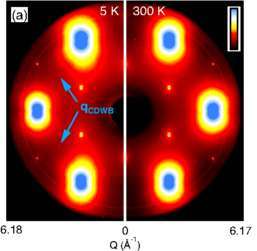Newly discovered material property may lead to high temp superconductivity

Researchers at the U.S. Department of Energy's (DOE) Ames Laboratory have discovered an unusual property of purple bronze that may point to new ways to achieve high temperature superconductivity.
While studying purple bronze, a molybdenum oxide, researchers discovered an unconventional charge density wave on its surface.
A charge density wave (CDW) is a state of matter where electrons bunch together in a repeating pattern, like a standing wave of surface of water. Superconductivity and charge density waves share a common origin, often co-exist, and can compete for dominance in certain materials.
Conventional CDWs and superconductivity both arise from electron-phonon interactions, the interaction of electrons with the vibrations of the crystal lattice. Electron-electron interactions are the likely origin of unconventional, high-temperature superconductivity such as found in copper- and iron-based compounds.
Unconventional, electron-electron driven CDW are extremely rare and its discovery here is important, because the material showed an 'extraordinary' increase of CDW transition temperature from 130K (-143°C) to 220K (-53 °C) and a huge increase of energy gap at the surface.
Both are properties essential for CDW and high-temperature superconductivity, explained Adam Kaminski, Ames Laboratory scientist and professor in the Department of Physics and Astronomy at Iowa State University.
"This was an accidental but very exciting discovery," said Kaminski. "We were studying this material because its one-dimensional structure makes it quite interesting. We saw strange things happening to the electronic band structure, but when we looked at the surface we were stunned by extraordinary enhancement of transition temperature and energy gap."
The science is further discussed in the paper, "Discovery of an Unconventional Charge Density Wave at the Surface of K0.9Mo6O17", co-authored by Daixiang Mou, A. Sapkota, H.-H. Kung, Viktor Krapivin, Yun Wu, A. Kreyssig, Xingjiang Zhou, A. I. Goldman, G. Blumberg, Rebecca Flint, and Adam Kaminski; and featured as an Editor's Suggestion in Physical Review Letters.
More information: Daixiang Mou et al. Discovery of an Unconventional Charge Density Wave at the Surface of, Physical Review Letters (2016). DOI: 10.1103/PhysRevLett.116.196401
Journal information: Physical Review Letters
Provided by US Department of Energy





















